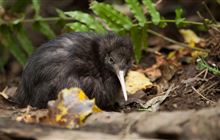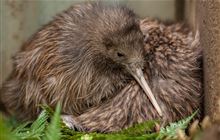Save Our Iconic Kiwi
Introduction
Kiwi conservation under the banner 'Save our Iconic Kiwi' aims to halt the decline of kiwi numbers.Goal to increase kiwi numbers
We have about 70,000 kiwi in New Zealand, inhabiting only a fraction of their former range. Across the country, only a quarter of wild kiwi live in safe habitat protected by predator control.
Kiwi populations around the country are declining at an average of 2% a year – a serious situation. It’s mostly due to predation upon kiwi chicks by stoats, cats, dogs and ferret, and 95-100% of all chicks that hatch in areas without predator control will die before breeding age
The goal for Save Our Iconic Kiwi is to turn this decline around, so that every type of kiwi is increasing in number.
The research behind Save Our Iconic Kiwi
Kiwi currently stand a much better chance of survival in areas where predators are controlled with traps and aerially applied 1080. Where work is being done to protect kiwi, the numbers are increasing. Our goal is to increase populations by at least 2% per year.
Previous research has shown that aerial 1080 operations combined with trapping increase North Island brown kiwi populations significantly. Only 5% of chicks survive to adulthood without predator control, but with adequate management that can increase to 60%.
In a recent study on Southern Fiordland tokoeka at Shy Lake in Fiordland, 0% of chicks survived to adulthood with nearly all of them preyed upon by stoats. After aerially applying 1080 bait, the survival rate increased to around 20%.
South Island kiwi
Only a small proportion of kiwi currently receive any form of management in the South Island and much of the kiwi population live in the wild. DOC’s focus is on protecting those kiwi species suffering the greatest rate of decline including Fiordland tokoeka and great spotted kiwi/roroa.
We are doing further research with great spotted kiwi to determine how successful aerial 1080 is at increasing their chick survival rates. Like Fiordland tokoeka, they are different in productivity and behaviour to North Island brown kiwi and live in predominantly mast-driven ecosystems which makes it harder to protect them.
Save the Kiwi in the North Island
Save the Kiwi has a focus on the North Island, where the majority of community-led kiwi conservation is centred. Its focus is on growing populations at kōhanga kiwi sites, establishing a future source of kiwi to release into safe areas in the wild.
Success will come from gathering a better understanding of how to effectively manage kiwi and working in collaboration with others.
Learn more about Save the Kiwi.
Protecting Fiordland tokoeka
In 2017, we started monitoring southern Fiordland tokoeka kiwi at Shy Lake, between Wet Jacket Arm and Breaksea Sound. The goal was to gather data before and after an aerial 1080 operation to ensure we are controlling predators in the most effective away to save the most kiwi across large, remote areas of Fiordland.
Over three years, none of the 34 tokoeka kiwi chicks being monitored at Shy Lake survived to adulthood. Most were victims of stoats, a huge setback for this already endangered species.
Research update
In 2020, the Shy Lake area was treated with 1080 for the first time and predator numbers were heavily reduced. Following this, there has been a clear improvement in the number of chicks making it to safe weight.
After the first application, survival increased by 20% in the first two years. Then, as large numbers of predators re-invaded the area, the survival rate of kiwi began to fall again. Another operation is planned in 2023.
Achieving a 20% increase in two years might not sound huge, but it’s enough to keep the population growing, and is much better than the 0% survival rate before aerial 1080 was used. Predator control needs to be sustained to ensure this growth continues.
The Fiordland Kiwi Diaries
Fiordland Kiwi Diaries is a heartfelt 3-part YouTube mini-series following Department of Conservation rangers in Fiordland as they work to save the iconic tokoeka kiwi.
The series follows dedicated DOC rangers as they traverse the wilderness tracking vulnerable kiwi chicks and monitoring the results of the area’s first 1080 predator control operation.
It also shows how important it is for Aotearoa, New Zealand to become predator free, so kiwi can roam freely throughout the country without being attacked by introduced predators.
Watch the trailer
You can also read about the work the Save Our Iconic Kiwi team have done in the blog series by Tim Raemaekers and other Fiordland kiwi rangers.


